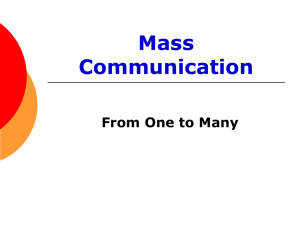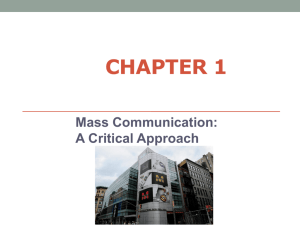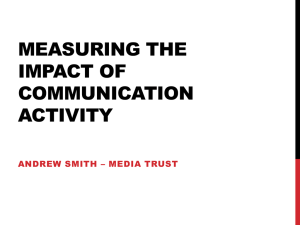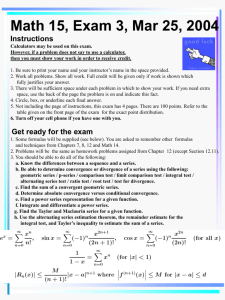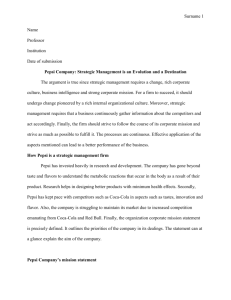Mass Communications: Critical Approach
advertisement
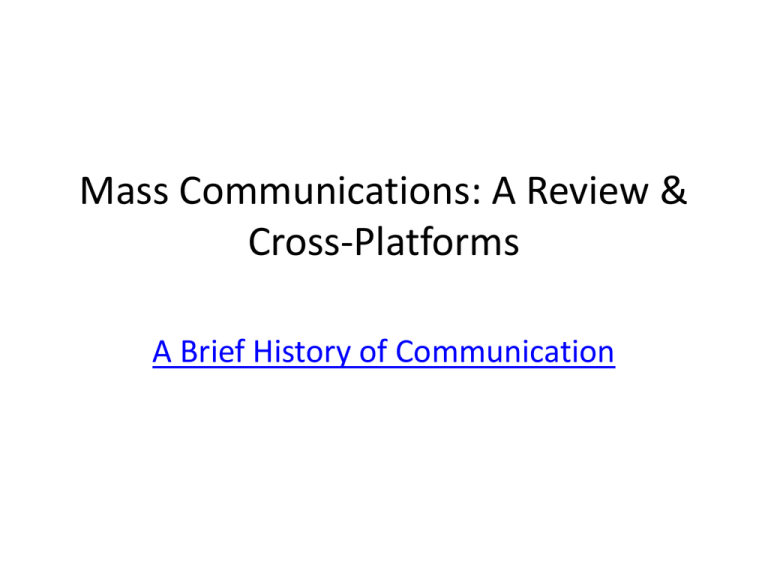
Mass Communications: A Review & Cross-Platforms A Brief History of Communication 2012 Presidential Election • The rise of social media and political clout turned out to play a larger role than traditional television advertising in the most recent presidential election. • It is worth asking whether TV will continue to play an outsized role in future federal elections. Culture and the Evolution of Mass Communication • Mass media are the cultural industries that produce and distribute – Songs – Novels – TV shows – Newspapers – Movies – Video games – Internet Services The Digital Era • The ability to send words, pictures, and sound using a digital code allowed for modern communication technology, including the Internet and cable television. This led to the emergence of email, blogging, and social media. The Digital Era Cont. • Digital communication redefined news and social interaction. – Bloggers have become an important part of the news industry. – E-mail has assumed some of the functions of the postal service. – Social media like Twitter and Facebook connect people in a new way. Figure 1.1: Daily Media Consumption by Platform, 2010 (8-to-18-year-olds) The Linear Model of Mass Communication • Senders (authors, producers) • Messages (programs, ads) • Mass media channel (TV, books) • Receivers (viewers, consumers) • Gatekeepers (editors, executive producers, media managers) • Feedback (messages from receivers back to senders) Cultural Model for Mass Communication • Recognizes that individuals bring diverse meanings to messages • Audiences actively affirm, interpret, refashion, or reject the messages and stories that flow through various media channels The Evolution of a New Mass Medium • Emergence or novelty stage • Entrepreneurial stage • Mass medium stage • Convergence stage Media Convergence • The term convergence is used by media critics and analysts to describe recent changes in media content and media companies. – 1. The Dual Roles of Media Convergence. Media convergence involves the technological merging of content as well as crossplatform, the business model of consolidation of media holdings under a corporate umbrella. – 2. Media Businesses in a Converged World. This business model is revealed through digital age strategies of companies like Amazon, Facebook, Apple, and Google. – 3. Media Convergence and Cultural Change. The Internet and social media have changed the ways in which media culture is engaged and consumed. Media multitasking has led to growing media consumption, particularly for younger people. Media Convergence cont. • Dual roles – Technological merging of content across different media channels – Cross platform, the consolidation of media holdings under one corporate umbrella • Media businesses – Companies like Google make money by selling ads rather than by producing content Media Convergence and Cultural Change • Changes in how we consume and engage with media culture – Watch TV shows on Hulu and Netflix or DVR/OnDemand options – Make media choices based on social media recommendations – Upload our own media – Discuss programs as we watch them through “livetweeting” Hashtags • Nike – #MakeItCount: • Nike’s #MakeItCount campaign started in 2012 as part an effort to publicize the release of the Fuel Band. It started with a viral YouTube effort, and then expanded to include Nike encouraging their fans and followers to tell them how they planned to “Make it Count” in 2012. Hashtags • HBO Game of Thrones – Influencer Boxes • HBO shipped “Influencer” boxes to celebrities, bloggers and influential Twitter, which contained physical items from the fictional world of Westeros, where the series takes place. The creative campaign show HBO’s belief that the best strategy to draw new subscribers is not just to promote the show itself (which they continue to do), but rather the idea of the show as a social media event. • In additional to several physical items and trinkets contained in a wooden box, the Influencer Box also includes “exclusive extras which the owner can use on their social media sites to show off their fandom,” which HBO is now extending out to the “real fans” through a collection of site-specific giveaways on sites. Hashtags • Pepsi unveiled its global, multiyear campaign Live for Now in 2012, and made social media, and the use of hashtags a core component of the large campaign. • The campaign includes TV, radio, cinema and outdoor advertising and Pepsi partnered with Twitter to organize a series of exclusive pop-up concerts. In conjunction with the roll out of the Live for Now marketing initiative, Pepsi also debuted Pepsi Pulse, a social mediadriven interactive dashboard for everything pop culture. • Pepsi – Pepsi Pulse

